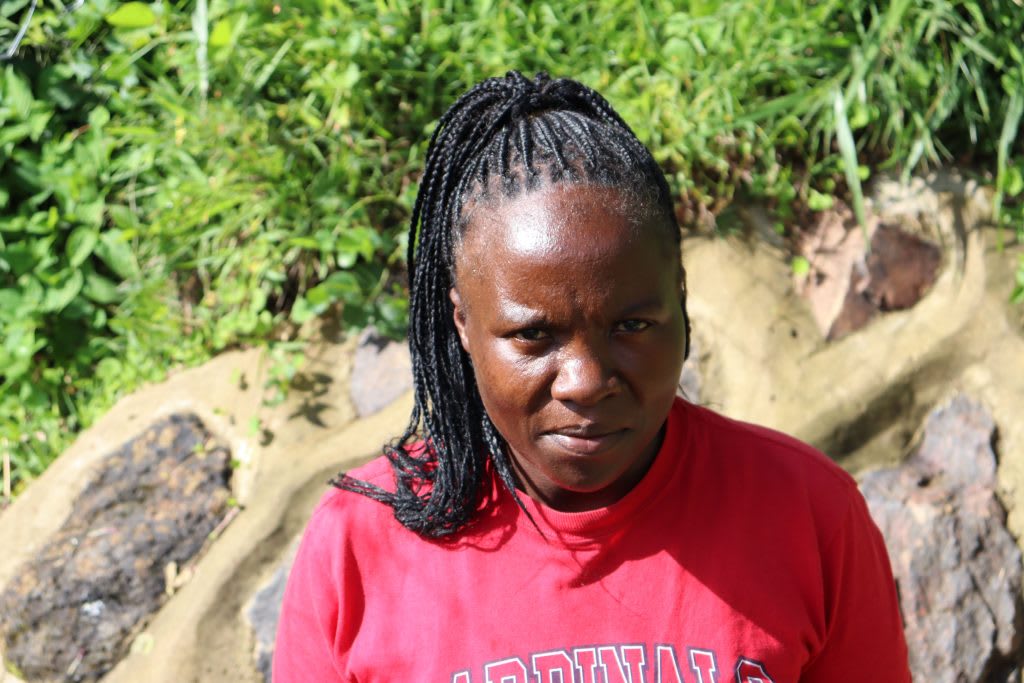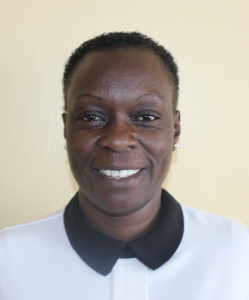August, 2024: Musungu Community Spring Protection Complete!
Musungu Community now has access to clean water! Thanks to your donation, we transformed their spring into a flowing source of naturally filtered water. We also installed a chlorine dispenser to provide added protection and trained the community on improved sanitation and hygiene practices. Together, these components will unlock the opportunity for community members to live better, healthier lives.

"My generation will use safe water for a long time. I and my family will use water to water crops during dry seasons. I will not lack vegetables to sell for income generation and also have enough to eat. The new water source will generate income because I will use the water to irrigate the vegetables during dry seasons and sell to generate income to pay fees for my children among other household needs," shared 38-year-old businesswoman Loice Askari.

Loice collecting clean water!
"The new waterpoint will make a difference because there will be no more waterborne diseases. They will no longer spend money on medication. Also, the protected spring will serve them long if they continue maintaining it properly. For the children, they will have sufficient time to concentrate on their academic work," she continued.
Children were just as excited as adults about the new water point.
"I am sure of safe and clean water any time after school because, after [the] rains, I could not draw clean water because of dirty water that used to cover the spring every time it rained. I [will] take the shortest time and go back home and do my studies on time. My academic performance will begin to improve for the better," said 14-year-old Getrine.

Getrine collecting water.
Preparing for Spring Protection
Community members worked together to source and carry all locally available construction materials to the spring. These included bricks, sand, stones, and fencing poles. Some people also chiseled away at large rocks to break them into gravel. Because people have to carry most items by hand, the material-collection process can take anywhere from a few weeks to months.

A child helps gather bricks for the spring.
When the community was ready, we sent a truck to deliver the remaining construction materials, including cement, plastic tarps, and hardware. Then, our construction artisan and field officers deployed to the spring to begin work. Individual households provided meals throughout each day to sustain the work team.
From Open Source to Protected Spring: A Step-by-Step Process
First, we cleared and excavated the spring area. Next, we dug a drainage channel below the spring and several runoff diversion channels above and around the spring. These help to divert surface contaminants away.
To ensure community members could still access water throughout the construction process, we also dug temporary channels around the construction site from the spring's eye. This allowed water to flow without disrupting community members' tasks or the construction work. Excavation created space for setting the spring's foundation, made of thick plastic, wire mesh, concrete, and waterproof cement.

Laying the foundation.
After establishing the base, we started brickwork to build the headwall, wing walls, and stairs. Once the walls had grown tall enough, we began one of the most crucial steps: setting the discharge pipe. The discharge pipe needs to be positioned low enough in the headwall so the water level never rises above the spring's eye, yet high enough to allow room for the average jerrycan (a 20-liter container) to sit beneath the pipe without making contact, which prevents cross-contamination.

Setting the discharge pipe.
If we place the discharge pipe too high above the spring's eye, back pressure could force water to emerge elsewhere. Too low, and community members would not be able to access the water easily. We embedded the pipe using clay (or mortar when the clay is in short supply) and placed it at an incline to ensure water flows in the right direction.
In coordination with brickwork, we pitched stones on both sides of the spring's drainage channel. We then cemented and plastered each stone, forming the rub walls. These walls discourage people and animals from standing in that area, which could cause soil erosion and a clogged drainage area.

Building the walls.
We then cemented and plastered both sides of the headwall and wing walls. These finishing layers reinforce the brickwork and prevent water in the reservoir from seeping through the walls. In turn, enough pressure builds in the reservoir box to push water out through the discharge pipe.
As the headwall and wing walls cured, we cemented and plastered the stairs and installed four tiles beneath the discharge pipe. The tiles protect the concrete from the falling water's erosive force while beautifying the spring and facilitating easy cleaning of the spring floor.

Stair construction.
The final stage of construction is backfilling the reservoir box behind the discharge pipe. We cleared the collection box of any debris that may have fallen during construction. Then we redirected the temporary diversion channels back into the reservoir box, channeling water into this area for the first time. We close all other exits to force water through only the discharge pipe.

Backfilling the soil.
We filled the reservoir area with the large, clean stones community members had gathered, arranging them in layers like a well-fitting puzzle. We covered the rocks with thick plastic to minimize potential contamination sources, then piled enough dirt on top to compensate for future settling.
Community members transplanted grass onto the backfilled soil to help prevent erosion. The collection area was fenced to discourage any person or animal from walking on it. Compaction can lead to disturbances in the backfill layers and potentially compromise water quality.

Grass planting.
The construction process took about two weeks of work and patience to allow the cement and plaster to finish curing. As soon as the spring was ready, people got the okay from their local field officers to fetch water.

Celebrating the spring!
We officially handed over the spring to mark the community's ownership of the waterpoint. "The ceremony was very successful. We had Assistant Chief Madam Lydia Khakasa, Village Elder Madam Pamela Moles and Community members gathered together to thank God for the flowing water. Madam Lydia who is [the] Assistant Chief, encouraged the members to take care of the protected spring, and they promised to take care of the protected spring daily without failure. The community members were very happy to receive the project. Finally, there were songs of praise to thank God for remembering the community," shared field officer Mary Afandi.
Training on Health, Hygiene, and More
Together with the community, we found their preferred date for training while considering other community calendar events, such as the agricultural season and social events. We requested a representative group of community members to attend training and relay the information learned to the rest of their families and friends.
When the day arrived, facilitators, Mary Afandi and Victor Musemi deployed to the site to lead the event. 26 people attended the training.

Mary Afandi teaching dental hygiene.
We covered several topics, including community participation in the project; leadership and governance; personal, dental, and environmental hygiene; water handling and treatment; spring maintenance; the importance of primary health care and disease prevention; family planning; soapmaking; how to make and use handwashing stations; and the ten steps of handwashing.

Training session.
During the leadership and governance session, we held an election for the newly formed water user committee leaders, who will oversee the maintenance of the spring. We also brainstormed income-generating activities. Community members can now start a group savings account for any future minor repairs to the spring and a cooperative lending group, enabling them to develop small businesses.

Soapmaking training.
Pamela Moles, 48, is a village elder and the chairperson of the water user committee. She was intrigued by the soapmaking demonstration, as she not only learned a new way to improve the hygiene of her home but also a new means of income! She said, "I normally buy the liquid soap at the market. However, what I have learned today has opened my eyes. Provided you have got the reagents, you [can] make your liquid soap. What we normally buy at the market is not good, like today's liquid soap. I will also make mine and sell [it] to community members who did not attend the training. I will earn some income from soapmaking."
Thank you for making all of this possible!









 Protected Spring
Protected Spring
 Rehabilitation Project
Rehabilitation Project


































